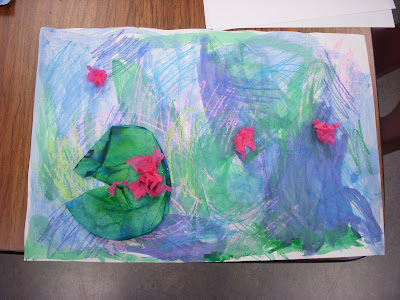One of our last stops on my awesome Spring Break with my friend Kate Mc Hugh in the OB (Ocean Beach area and we've been friends since college) was the San Diego Museum of Art. I saw some interesting pieces and an amazing exhibition of Japanese woodblock prints (we're studying Asian art right now!). But I am a slave to the museum art gift shops and so excited to spend my money on art education finds that are a lot of fun!! So I found this remarkable children's book that I've never seen before, called "The Boy Who Bit Picasso". I LOVE IT!!! It is a young boy, and son of famous photographer Lee Miller, and talks about the relationship between his family, Picasso, and other artists that would hang out with the family. It was so neat to hear and SEE first hand accounts and personal stories between Picasso and 'Tony', the son of the photographer. Lots of personal pictures and relations to his famous pieces of art and personal artworks made specifically for Tony and his family.
Here is a picture (above) of the summary of the book. The great thing about the book is that it's meant to be read by young readers! And the pictures and colors are amzing. Really cute and I really enjoyed reading this. I'm hoping on a free day in art near the end of the year to read with the document camera, have the students free draw and listen to the story.
Here are some pictures from the book with detail about first hand accounts of growing up with Picasso as a friend. I know what you're thinking. Why is it called 'The Boy Who Bit Picasso'?? It explains in the book how Picasso loved playing with Tony and they were on the floor pretending to act like fighting bulls and they got a little rough and Tony bit Picasso and PIcasso bit him back!! Hilarious friends. It really gives you an idea of how Picasso really loved children and believed in children being artists and remaining a 'child at heart' to identify with art and creativity. I love his famous quote: "Every child is an artist. The problem is to remain an artist once we grow up".
 |
| Homage to the Square. Josef Albers & I. Another great children's book about Joseph Albers life and his art "An Eye for Color" |
 |
| Kate and I trying to pull off some creative photography by the beach |
 |
| Trompe loeil! San Diego Museum of Art |
 |
| Trompe-l'eoi photo upclose! WOw |
 |
| Evening art gallery Chihuly knock offs:P |
 |
| perfectly pedicured toes hittin the beach and tides coming in! |
 |
| Kate and I on the OB beach just 5 minute walk from her apt!! |
 |
| art this way!! Ok, kind of. |















































